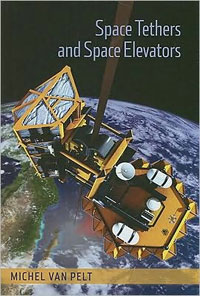Review: Space Tethers and Space Elevatorsby Jeff Foust
|
| While the book does a good job explaining the technology involved, one aspect it lacks is a discussion why tethers in particular have to date failed to realize their potential. |
Tethers get top billing in van Pelt’s book and take up over two-thirds of the book. After an introduction to basic orbital mechanics, he explains how tethers can be used to alter the orbits of spacecraft; the tests that have been done to date with tethers, from early experiments on the final Gemini missions through two failed large-scale tether experiments on shuttle flights in the 1990s to more recent smaller-scale tests; and potential applications of tethers. Two later chapters of the book delve into space elevators, including the history of the concept, the science and engineering involved, and the various challenges involved in trying to build one.
While Space Tethers and Space Elevators does a good job explaining the technology involved, one aspect the book lacks is a discussion why tethers in particular have to date failed to realize their potential. After all, tethers offer the ability to shift orbits without expending propellant, a powerful capability for the typical mass-constrained satellite. Yet the research into tethers has been limited, and the record of flight experiments features a number of failures, the shuttle Tethered Satellite System being the best known but hardly only case. Is this simply a case where insufficient resources have been focused on the technology (and, if so, why), or are there fundamental issues with tether technology that need to be addressed?
Given the mixed record of deploying tethers in space extending several kilometers, it seems unlikely that we’ll see the development of a space elevator—effectively a tether 100,000 kilometers long anchored at one end on the Earth—any time soon. Still, the attractiveness of the technology, which promises to greatly reduce the cost of space access and do away with rockets, means that we’ll see people continue to study it at some low level, through competitions like the Space Elevator Games and various conferences. And who knows: perhaps this will lead to a breakthrough that makes the space elevator technically and financially feasible.
